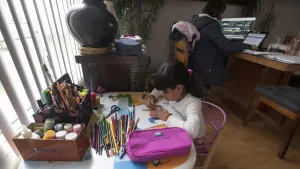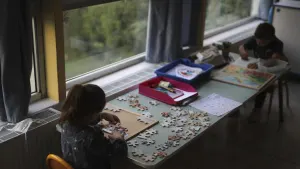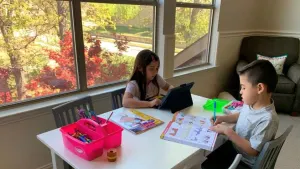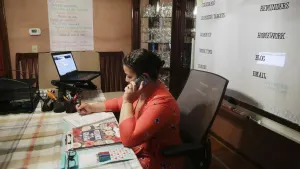Guide: Resources for families to talk about school shootings
How do we talk to our kids about gun violence? Here's a guide with tips and resources.
Share:
More Stories

4 ways parents can help kids have a great summer at camp
1,214ds ago
10 online learning tools for students to use at home
1,806ds ago11:21:40

6 tips for home schooling children and remote learning
1,807ds ago
7 online remote learning tools for educators
1,807ds ago8:38:20

17 tips for students, parents and teachers using video in virtual classes
1,807ds ago12:31:07

Are your children required to wear a face shield at school? 5 things to know
1,863ds ago
4 ways parents can help kids have a great summer at camp
1,214ds ago
10 online learning tools for students to use at home
1,806ds ago11:21:40

6 tips for home schooling children and remote learning
1,807ds ago
7 online remote learning tools for educators
1,807ds ago8:38:20

17 tips for students, parents and teachers using video in virtual classes
1,807ds ago12:31:07

Are your children required to wear a face shield at school? 5 things to know
1,863ds agoHow do we talk to
our kids about gun violence?
High profile acts of violence can confuse children who may
feel in danger or worry that their friends or loved
ones are at risk.
Below is a guide with tips and resources for families:
SENSE OF NORMALCY
The National Association of School Psychologists (NASP) says
parents and school personnel can help children feel safe by establishing a
sense of normalcy and security and talking with them about their fears.
REASSURANCE
Reassure children that they are safe. Emphasize that schools
are very safe. Validate their feelings. Explain that all feelings are OK when a
tragedy occurs. Let children talk about their feelings, help put them into
perspective, and assist them in expressing these feelings appropriately, NASP
recommends.
Keep your explanations developmentally appropriate - CLICK
HERE for Common Sense Media's age-based approach to discussing news of school
shootings with kids.
Early elementary school children need brief, simple information
that should be balanced with reassurances that their school and homes are safe
and that adults are there to protect them.
Upper elementary and early middle school children will be
more vocal in asking questions about whether they truly are safe and what is
being done at their school.
Upper middle school and high school students will have
strong and varying opinions about the causes of violence in schools and
society.
MAKE TIME TO TALK
Let their questions be your guide as to how much information
to provide. Be patient; children and youth do not always talk about their
feelings readily. Watch for clues that they may want to talk, such as hovering
around while you do the dishes or yard work. Some children prefer writing,
playing music, or doing an art project as an outlet. Young children may need
concrete activities (such as drawing, looking at picture books, or imaginative
play) to help them identify and express their feelings.
Some children may not express their concerns verbally.
Changes in behavior, appetite, and sleep patterns can also indicate a child’s
level of anxiety or discomfort. In most children, these symptoms will ease with
reassurance and time. However, some children may be at risk for more intense
reactions. Children who have had a past traumatic experience or personal loss,
suffer from depression or other mental illness, or with special needs may be at
greater risk for severe reactions than others. Seek the help of mental health
professional if you are at all concerned.
NATIONAL PARENT HELPLINE: Call the National Parent Helpline
at 1-855-4A PARENT (1-855-427-2736) to get emotional support from a trained
advocate. They are available Monday through Friday from 10 a.m. to 7 p.m.
REVIEW SAFETY PROCEDURES
This should include procedures and safeguards at school and
at home. Help children identify at least one adult at school and in the
community to whom they go if they feel threatened or at risk.
LIMIT TELEVISION VIEWING
Limit television viewing and be aware if the television is
on in common areas. Developmentally inappropriate information can cause anxiety
or confusion, particularly in young children. Adults should be mindful of the
content of conversations that they have with each other in front of children.
Adults should also be mindful of being overexposed to the
news - as it could increase your stress. The images can be very powerful in
reawakening your feeling of distress. The American Psychological Association
recommends that adults schedule some breaks to distract themselves from
thinking about the incident and focus instead on something they enjoy or lift
their spirits.
MAINTAIN A NORMAL ROUTINE
Keeping to a regular schedule can be reassuring and promote
physical health. Ensure that children get plenty of sleep, regular meals, and
exercise. Encourage them to keep up with their schoolwork and extracurricular
activities but don’t push them if they seem overwhelmed.
STRIVE FOR BALANCE
When a tragedy occurs, it’s easy to become overwhelmed and
have a negative or pessimistic outlook. Balance that viewpoint by reminding
yourself of people and events which are meaningful and comforting, even
encouraging. Striving for balance empowers you and allows for a healthier
perspective on yourself and the world around you.
NASP has these suggested points to emphasize when talking to
children:
1. Schools are safe places. School staff works with parents
and public safety providers (local police and fire departments, emergency
responders, hospitals, etc.) to keep you safe.
2. The school building is safe because … (cite specific
school procedures).
We all play a role in the school safety. Be observant and
let an adult know if you see or hear something that makes you feel
uncomfortable, nervous or frightened.
3. There is a difference between reporting, tattling or
gossiping. You can provide important information that may prevent harm either
directly or anonymously by telling a trusted adult what you know or hear.
4. Although there is no absolute guarantee that something
bad will never happen, it is important to understand the difference between the
possibility of something happening and probability that it will affect you (our
school community).
5. Senseless violence is hard for everyone to understand.
Doing things that you enjoy, sticking to your normal routine, and being with
friends and family help make us feel better and keep us from worrying about the
event.
6. Sometimes people do bad things that hurt others. They may
be unable to handle their anger, under the influence of drugs or alcohol, or
suffering from mental illness. Adults (parents, teachers, police officers,
doctors, faith leaders) work very hard to get those people help and keep them
from hurting others. It is important for all of us to know how to get help if
we feel really upset or angry and to stay away from drugs and alcohol.
7. Stay away from guns and other weapons. Tell an adult if
you know someone has a gun. Access to guns is one of the leading risk factors
for deadly violence.
More from News 12
2:07

Children of fallen Detective Didarul Islam given scholarships from NFL and non-profit 'Folds of Honor'
2:05

Some city schools will have direct access to 911 in an emergency
1:43

2,500 students and staff evacuated due to bomb threat at Christopher Columbus Campus

News 12 and DonorsChoose partner to help teachers raising money for classrooms
1:44

Mother says Bedford Park school failed to protect her special needs son after being bitten by student
1:43
